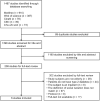Social Isolation of Older Adults With Diabetes
- PMID: 35937276
- PMCID: PMC9350511
- DOI: 10.1177/23337214221116232
Social Isolation of Older Adults With Diabetes
Abstract
We aimed to conduct a scoping review of social isolation in elderly patients with diabetes and to clarify current knowledge and gaps and future challenges. A literature search was conducted using Medline, Web of Science, CINAHL, CiNii, and Ichushi, and included studies with an eligibility criterion of a survey of social isolation in elderly patients with diabetes and aged ≥60 years. Social isolation was defined as limited or non-face-to-face contact with family and community. A data extraction form describing characteristics of studies incorporated in the present review was prepared. A total of six studies met eligibility criterion (sample size, 451-3,500). Subjects' age averaged 67 years, and 42% were female. Social isolation ranged from 9% to 49%. Factors related to social isolation included vascular complications,decreased activities of daily living, death, dementia, glycemic fluctuation, disturbance of lifestyle habits, and poor self-management and -rated health. However, research on the cause and mechanism of the relationship and impact of sex-based differences was lacking. In conclusion, additional research is needed on the definition of social isolation in elderly patients with diabetes, the causal relationship with related factors and their mechanisms, and the relationship with other outcomes.
Keywords: aging; diabetes mellitus; elderly; social interaction; social isolation.
© The Author(s) 2022.
Conflict of interest statement
Declaration of Conflicting Interests: The author(s) declared no potential conflicts of interest with respect to the research, authorship, and/or publication of this article.
Similar articles
-
Social Participation Benefit in Elderly Patients With Diabetes: A Scoping Review.Gerontol Geriatr Med. 2022 Apr 18;8:23337214221093887. doi: 10.1177/23337214221093887. eCollection 2022 Jan-Dec. Gerontol Geriatr Med. 2022. PMID: 35464637 Free PMC article.
-
Promoting and supporting self-management for adults living in the community with physical chronic illness: A systematic review of the effectiveness and meaningfulness of the patient-practitioner encounter.JBI Libr Syst Rev. 2009;7(13):492-582. doi: 10.11124/01938924-200907130-00001. JBI Libr Syst Rev. 2009. PMID: 27819974
-
Prevention of falls and fall-related injuries in community-dwelling seniors: an evidence-based analysis.Ont Health Technol Assess Ser. 2008;8(2):1-78. Epub 2008 Oct 1. Ont Health Technol Assess Ser. 2008. PMID: 23074507 Free PMC article.
-
[Social support availability and psychological well-being among the socially isolated elderly. Differences by living arrangement and gender].Nihon Koshu Eisei Zasshi. 2011 Jun;58(6):446-56. Nihon Koshu Eisei Zasshi. 2011. PMID: 21970078 Japanese.
-
Social isolation in people with type 2 diabetes: A concept analysis.Heliyon. 2024 Aug 13;10(16):e36261. doi: 10.1016/j.heliyon.2024.e36261. eCollection 2024 Aug 30. Heliyon. 2024. PMID: 39247378 Free PMC article. Review.
Cited by
-
Association of diabetes-related factors with life satisfaction and sleep disturbances among Indian ageing adults: Evidence from a large-scale study.Health Psychol Open. 2025 Jul 28;12:20551029251362660. doi: 10.1177/20551029251362660. eCollection 2025 Jan-Dec. Health Psychol Open. 2025. PMID: 40735299 Free PMC article.
-
The hidden impact: social isolation and inflammation's role in pancreatic cancer risk among those with diabetes.BMC Cancer. 2025 Jan 10;25(1):58. doi: 10.1186/s12885-025-13470-z. BMC Cancer. 2025. PMID: 39794805 Free PMC article.
-
Social network interventions for dietary adherence among adults with type 2 diabetes: a systematic review and meta-analysis protocol.BMJ Open. 2024 Nov 9;14(11):e082946. doi: 10.1136/bmjopen-2023-082946. BMJ Open. 2024. PMID: 39521477 Free PMC article.
-
Effective Interventions for Homebound Older Adults With Type 2 Diabetes: A Systematic Review.Curr Diab Rep. 2025 Apr 5;25(1):29. doi: 10.1007/s11892-025-01584-4. Curr Diab Rep. 2025. PMID: 40186848 Free PMC article.
-
Experiences of adults with type 2 diabetes mellitus with low socioeconomic status: a qualitative study.BMC Public Health. 2025 Jan 30;25(1):381. doi: 10.1186/s12889-025-21582-1. BMC Public Health. 2025. PMID: 39885416 Free PMC article.
References
-
- Arksey H., O’Malley L. (2005). Scoping studies: Towards a methodological framework. International Journal of Social Research Methodology, 8(1), 19–32. 10.1080/1364557032000119616 - DOI
-
- Bennett R. (1980). The concept and measurement of social isolation. In Bennett R. (Ed.), Aging, isolation and resocialization (pp. 9–26). Van Nostrand Reinhold.
-
- Brinkhues S., Dukers-Muijrers N. H., Hoebe C. J., van der Kallen C. J., Koster A., Henry R. M., Stehouwer C. D., Savelkoul P. H., Schaper N. C., Schram M. T. (2018). Social network characteristics are associated with type 2 diabetes complications: The Maastricht study. Diabetes Care, 41(8), 1654–1662. 10.2337/dc17-2144 - DOI - PubMed
Publication types
LinkOut - more resources
Full Text Sources
Miscellaneous


